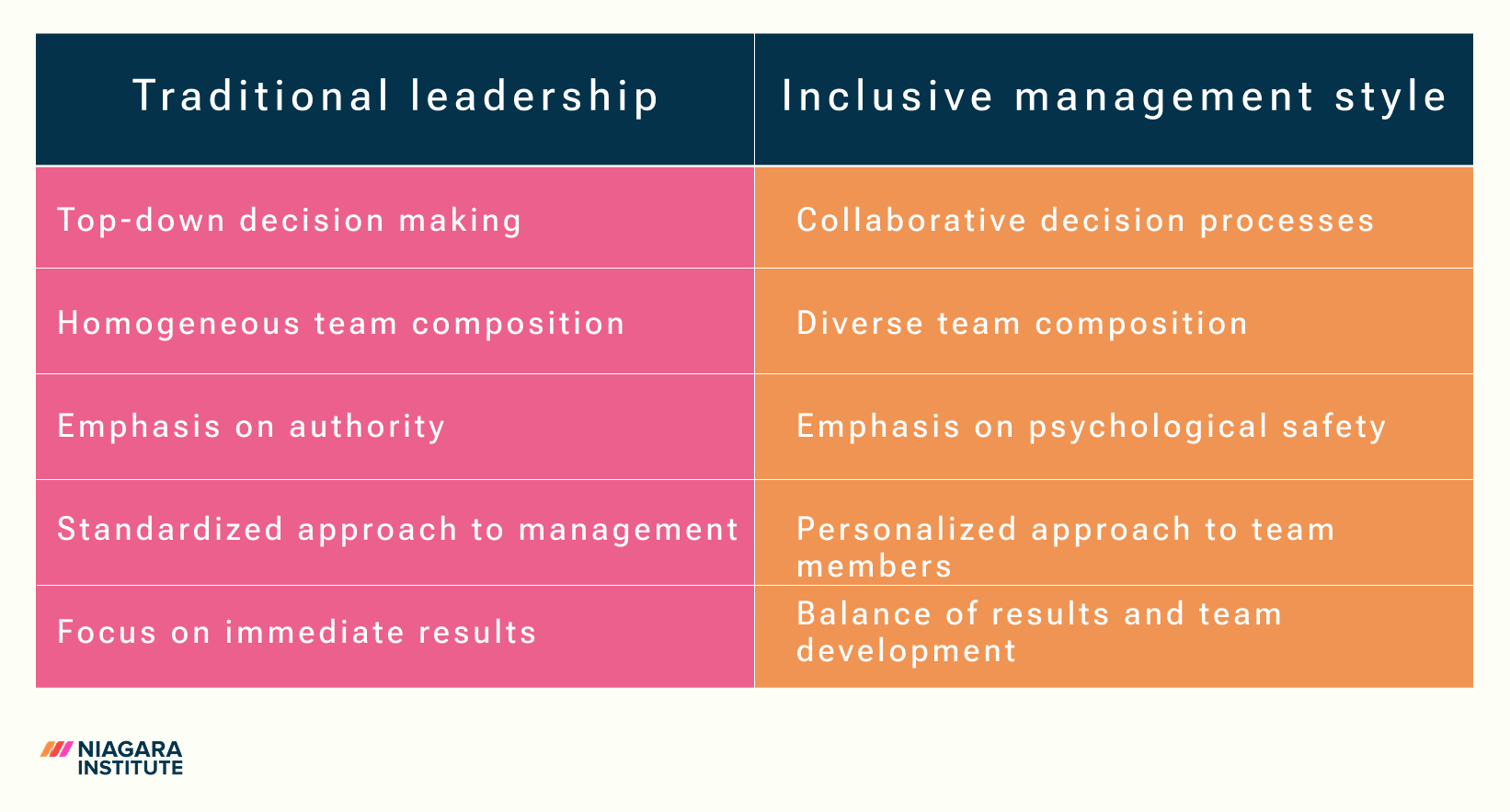Many leaders remain unaware of how their behaviors might be shutting down diversity of thought, stifling innovation, and ultimately driving talent away.
The most troubling part? Many exclusionary leadership patterns happen unconsciously, with well-intentioned leaders genuinely believing they're creating an open environment while their teams experience something entirely different.
By recognizing the warning signs of non-inclusive leadership early, you can transform your approach and create a workplace where everyone feels valued, heard, and empowered to contribute their best ideas.
Understanding What Makes Leadership Inclusive
Defining Inclusive Leadership in Today's Workplace
Inclusive leadership involves intentionally creating an environment where diverse perspectives are not just tolerated but actively sought out and incorporated into decision-making processes. It requires leaders to recognize their own biases, adapt their communication styles, and ensure equitable opportunities for all team members.
Inclusive leaders demonstrate a combination of awareness, authenticity, and accountability. They understand that different team members have unique needs and contributions, and they take responsibility for ensuring everyone has what they need to succeed.
Research from Deloitte shows that teams with inclusive leaders are:
- 17% more likely to report high performance
- 20% more likely to make high-quality decisions
- 29% more collaborative
Inclusive leaders demonstrate six signature traits:
- Cultural intelligence - Understanding different cultural contexts and norms
- Curiosity - Seeking diverse perspectives and challenging assumptions
- Collaboration - Creating environments where teamwork flourishes across differences
- Commitment - Dedication to diversity as a business strategy, not just compliance
- Courage - Willingness to speak up on difficult topics and challenge the status quo
- Cognizance - Self-awareness of personal biases and their potential impact
Inclusive Management Style vs. Traditional Leadership
An inclusive management style fundamentally differs from traditional approaches in several key ways:

Research shows that leaders who adopt an inclusive management style create environments where innovation flourishes and employee engagement significantly increases. According to a study by BCG, companies with above-average diversity on their leadership teams report 19% higher innovation revenue than companies with below-average leadership diversity.
Why Traditional Leadership Models Often Fall Short
Many traditional leadership styles were developed in more homogeneous work environments where conformity was valued over diversity. These approaches often emphasize hierarchy, authority, and a one-size-fits-all mentality that can unintentionally exclude valuable voices.
Command-and-control leadership models typically reward those who think, communicate, and problem-solve in ways that mirror the leader's own style, creating leadership blindspots that can be damaging to team morale and performance.
The Business Case for Inclusive Leadership
Research consistently shows that inclusive teams outperform their peers. McKinsey's research found that companies in the top quartile for gender diversity were 25% more likely to achieve above-average profitability compared to their counterparts.
Beyond financial outcomes, inclusive leadership qualities foster environments where:
- Innovation flourishes through diverse perspectives
- Employee engagement increases significantly
- Organizations attract and retain top talent more effectively
- Teams demonstrate greater resilience during challenges
Can Inclusive Leadership be Developed? Key Research Findings
The research is clear: inclusive leadership can be both learned and developed.
A comprehensive study by Russell Reynolds Associates found that leaders who received targeted training in inclusive behaviours showed:
- 28 % more inclusive actions (as rated in 360° feedback)
- a 46 % better ability to notice exclusion
- 39 % greater confidence in addressing DEI challenges.
The inclusive leadership developmentjourney involves:
- Self-awareness and assessment of current leadership patterns
- Education about diverse experiences and perspectives
- Practice of specific inclusive behaviors
- Feedback and accountability mechanisms
- Continuous learning and refinement
Warning Sign #1: You're the Last to Hear Bad News
Why Employees Hide Problems from Non-Inclusive Leaders
When team members consistently shield you from negative information, it signals they don't feel safe sharing challenges or mistakes. This pattern emerges when leaders have previously responded to problems with blame, dismissiveness, or disproportionate reactions.
The dangerous result? Issues fester until they become crises that could have been addressed earlier with minimal impact.
Creating Psychological Safety for Open Communication
Psychological safety—the belief that one won't be punished or humiliated for speaking up with ideas, questions, concerns, or mistakes—is fundamental to inclusive environments. When team members feel psychologically safe, they're more likely to:
- Raise potential problems before they escalate
- Share innovative but untested ideas
- Admit mistakes and learn from them quickly
- Challenge assumptions constructively
How to Encourage Honest Feedback from Your Team
To foster an environment where difficult news flows freely:
- Explicitly state that you value honesty over comfort
- Respond to bad news with curiosity rather than judgment
- Acknowledge and thank those who bring challenges to light
- Model vulnerability by admitting your own mistakes
- Create multiple feedback channels, including anonymous options
Warning Sign #2: High Employee Turnover in Your Department
The Connection Between Leadership Style and Retention
Studies consistently show that people don't leave companies—they leave managers. When there's a high turnover rates in your department that exceed organizational averages, it's a clear indicator that something in your leadership style may be pushing valuable talent away.
Pay particular attention if you notice patterns in who leaves: Are certain demographics or personality types more likely to exit? This could indicate unconscious biases in your leadership approach.
Exit Interview Patterns That Reveal Leadership Problems
While departing employees may cite reasons like "better opportunities" or "career growth" during exit interviews to avoid burning bridges, listen carefully for coded language that might indicate exclusionary leadership:
- "I didn't feel my contributions were valued"
- "There wasn't enough transparency in decision-making"
- "I didn't see a path forward here"
- "The culture wasn't the right fit for me"
Strategies to Build a Team People Want to Stay With
To improve employee retention strategies:
- Conduct regular stay interviews to understand what keeps your team engaged
- Create individualized development plans that acknowledge unique strengths and aspirations
- Ensure equitable visibility and opportunities for all team members
- Recognize contributions in ways that resonate with each individual
Warning Sign #3: You Don't Trust Your Team Members
How Lack of Trust Manifests in Leadership Behaviors
If you find yourself frequently checking in on your team's work, redoing tasks yourself, or hesitating to delegate important projects, you're exhibiting classic signs of leadership trust issues. While you might justify this behavior as ensuring quality, it sends a powerful message that you don't believe in your team's capabilities.
This lack of trust often stems from a fixed mindset about capability—believing that either people "have it" or they don't, rather than seeing potential for growth and development.
The Impact of Distrust on Team Performance
When team members sense your distrust, several damaging patterns emerge:
- Innovation decreases as people stick to "safe" approaches
- Motivation wanes when autonomy is lacking
- Leadership accountability diminishes as team members stop taking ownership
- Skill development stagnates without challenging opportunities
Building a Foundation of Trust as a Leader
To strengthen leadership trust building:
Warning Sign #4: You're Always Micromanaging
The Psychological Impact of Micromanagement
Micromanagement doesn't just frustrate employees—it fundamentally undermines their sense of agency and professional identity. Research shows that excessive oversight triggers the same neurological threat responses as physical danger, activating our fight-flight-freeze response and reducing cognitive capacity.
Over time, this creates a vicious cycle where team members stop bringing their full capabilities to work and become increasingly dependent on direction, seemingly "proving" that close management was necessary all along.
Signs You're Micromanaging Without Realizing It
You might be micromanaging if you:
- Feel the need to be copied on all emails
- Regularly take back delegated tasks when they aren't done "your way"
- Find yourself giving step-by-step instructions rather than overall direction
- Can't resist making small corrections to completed work
- Feel anxious when you don't know exactly what your team is doing
Delegating Effectively While Maintaining Quality
To move from micromanaging to effective delegation:
- Clearly define outcomes and success criteria upfront
- Establish checkpoints for feedback rather than continuous oversight
- Ask team members what level of support they need rather than assuming
- Focus on coaching leadership approach instead of directing
- Recognize there are multiple effective approaches to achieving goals
Warning Sign #5: Employee Growth Has Stalled
How Non-Inclusive Leadership Limits Development
When leaders play favorites or have rigid ideas about what constitutes "high potential," they often inadvertently create development deserts for team members who don't fit their preconceived notions of talent. This pattern typically impacts underrepresented groups disproportionately.
Non-inclusive leaders tend to invest development resources primarily in those who remind them of themselves or who communicate in familiar ways, missing the opportunity to cultivate diverse talent.
Creating Growth Opportunities for Diverse Team Members
To ensure equitable development for all:
- Implement structured processes for identifying growth opportunities
- Create diverse mentoring circles rather than one-to-one matches only
- Ensure stretch assignments are distributed equitably across different team members
- Recognize and value different leadership and communication styles
- Partner with your human resources department to track development metrics by demographics
Measuring Employee Development Beyond Performance Reviews
Look beyond traditional performance metrics to assess development:
- Track skill acquisition and knowledge transfer
- Monitor lateral moves that build cross-functional expertise
- Assess increases in project complexity and scope
- Measure contributions to others' success (mentoring, knowledge sharing)
- Evaluate growth in influence and impact regardless of title changes
Warning Sign #6: Your Team Is Reluctant to Speak Up in Meetings
Meeting Dynamics That Reveal Leadership Problems
When meetings consistently feature the same few voices while others remain silent, it signals a workplace culture issue. This pattern often indicates that certain perspectives are valued over others or that previous contributions were dismissed or interrupted.
Watch for nonverbal cues: Are some team members physically withdrawing? Do they appear to have something to say but hold back? These subtle signals often reveal exclusionary dynamics that you might otherwise miss.
Techniques for Encouraging All Voices to Be Heard
To create more inclusive meeting environments:
- Distribute meeting agendas in advance so everyone can prepare thoughtful contributions
- Implement a round-robin approach for certain discussion points
- Practice "amplification"—publicly acknowledging and building on others' ideas
- Actively invite input from quieter team members
- Address interruptions firmly but respectfully
Restructuring Meetings for Maximum Inclusion
Consider these structural changes to your meetings:
- Begin with a brief check-in to help everyone transition and feel included
- Use digital tools that allow anonymous contributions or voting
- Break larger groups into pairs or trios for initial discussions
- Assign rotating roles like facilitator, timekeeper, and note-taker
- Schedule dedicated reflection time during or after meetings
Warning Sign #7: You Avoid Difficult Conversations About Diversity
Why Uncomfortable Topics Are Essential for Inclusive Leadership
Avoiding conversations about diversity and representation doesn't make challenges disappear—it just ensures they remain unaddressed. True inclusive leadership requires courage to engage with uncomfortable topics, acknowledge different lived experiences, and address systemic inequities.
When leaders sidestep these discussions, they inadvertently signal that maintaining comfort takes precedence over creating true belonging for all team members.
Frameworks for Navigating Sensitive Conversations
To approach difficult conversations productively:
- Begin with clear intentions and ground rules
- Focus on impact rather than intent
- Use "both/and" thinking rather than "either/or"
- Acknowledge that discomfort is part of growth
- Center the conversation on systems and patterns rather than individuals
Building Cultural Competence as a Leader
Developing cross-cultural leadership competency:
Warning Sign #8: You Focus on Weaknesses More Than Strengths
The Deficit-Based Leadership Approach
A consistent focus on what's wrong rather than what's right creates a culture of insecurity and risk aversion. Traditional performance management often emphasizes fixing weaknesses, which can be demotivating and inefficient compared to building on existing strengths.
This deficit-based approach typically leads to incremental improvements in weak areas rather than exponential growth in areas of natural talent and passion.
Shifting to a Strengths-Based Leadership Model
Research from Gallup shows that teams who focus on strengths experience:
A strengths-based leadership approach doesn't ignore weaknesses but addresses them by partnering complementary strengths or developing just enough competence to prevent them from being obstacles.
Balancing Growth Areas with Positive Reinforcement
To implement a balanced approach:
- Begin performance discussions with strengths and accomplishments
- Frame development areas in terms of opportunities rather than deficits
- Create team compositions that leverage complementary strengths
- Look for tasks that energize team members rather than just those they can do
- Provide at least three pieces of positive feedback for every constructive criticism
Warning Sign #9: Your Decision-Making Process Lacks Diverse Input
The Danger of Homogeneous Decision Making
When key decisions are consistently made by similar individuals with shared backgrounds and perspectives, organizations face increased risk of:
- Blindspots that lead to major strategic errors
- Solutions that work for some but not all stakeholders
- Reduced innovation due to limited viewpoints
- Disengagement from those whose input is never sought
Creating Inclusive Decision-Making Structures
To build more inclusive leadership decision-making frameworks:
- Clarify which decisions require input, consultation, or consensus
- Create structured processes for gathering diverse perspectives before key decisions
- Implement decision-making tools that reduce unconscious bias
- Ensure representation from different functions, levels, and backgrounds
- Allow sufficient time for thoughtful consideration rather than rushed judgments
How to Solicit and Incorporate Diverse Perspectives
Practical techniques for gathering diverse input:
- Use pre-meeting surveys to collect thoughts from all team members
- Practice "reverse mentoring" where junior team members advise senior leaders
- Create cross-functional task forces for important initiatives
- Implement structured debate techniques like "Red Team/Blue Team"
- Track who speaks and whose ideas are implemented to identify patterns
Warning Sign #10: You Resist Change and Innovation
Why Change Resistance Signals Leadership Problems
Leaders who consistently maintain "the way we've always done things" often unintentionally exclude new approaches that could benefit from diverse thinking. This resistance to change stems from:
- Comfort with established processes that worked for them personally
- Unconscious preference for familiar communication and work styles
- Fear of losing control or authority
- Insufficient exposure to alternative approaches
Creating a Culture That Embraces Innovation
To foster an environment where innovation flourishes:
- Explicitly reward experimentation, even when outcomes aren't perfect
- Create protected spaces for testing new approaches
- Invite and celebrate diverse thinking styles
- Model curiosity and openness to alternative methods
- Implement systematic processes for evaluating and implementing new ideas
Leading Through Organizational Change Inclusively
During periods of leadership strategy during organizational change:
- Ensure change leadership teams include diverse perspectives
- Create multiple channels for feedback throughout change processes
- Acknowledge that change impacts different groups differently
- Provide varied support options during transitions
- Measure the impact of changes across different demographics
Transforming Your Leadership Style: A Path Forward
Self-Assessment Tools for Leadership Inclusivity
Begin with honest self-reflection using validated assessment tools:
- The Inclusive Leadership Assessment (ILA)
- Implicit Association Test (IAT) to identify unconscious biases
- 360-degree feedback specifically focused on inclusion behaviors
- Cultural Intelligence (CQ) assessments
Inclusive Leadership Assessment Tool: How Inclusive Is Your Leadership?
To assess your current inclusive leadership capabilities, ask yourself these essential questions:
- Do I actively seek out and incorporate perspectives different from my own?
- Can my team members disagree with me openly without fear of consequences?
- Do I ensure all team members have equitable access to growth opportunities?
- Am I aware of my own biases and take steps to mitigate them?
- Do I create space for different communication and work styles?
- Do I build diverse teams intentionally?
- Do I notice and address exclusionary behaviors when they occur?
- Do I share credit widely and acknowledge diverse contributions?
- Am I comfortable discussing topics related to diversity and inclusion?
- Do I continuously educate myself about experiences different from my own?
Score yourself from 1-5 on each question, with 5 being "consistently" and 1 being "rarely." A score of 40-50 suggests strong inclusive leadership practices, 30-39 indicates progress with room for growth, and below 30 signals significant development opportunities.
Creating Your Personal Leadership Development Plan
A comprehensive leadership development plan should include:
- Specific, measurable inclusive leadership behaviors to develop
- Resources needed for growth (training, mentorship, experiences)
- Accountability partners who will provide honest feedback
- Realistic timelines that acknowledge that behavioral change takes time
- Methods to measure progress beyond self-assessment

Measuring Progress and Celebrating Small Wins
Sustainable change requires recognizing progress along the way:
- Establish baseline metrics before beginning your development journey
- Track improvements in team engagement, participation, and retention
- Collect regular feedback on specific inclusive behaviors
- Document and celebrate moments when inclusive leadership made a difference
- Share your learning journey with others to normalize growth and development
When to Seek Professional Development for Leadership Growth
Leadership Coaching Options for Inclusive Leadership
Working with a leadership coach can accelerate your development through:
- Personalized feedback and development strategies
- Safe space to explore blindspots and challenges
- Accountability for practicing new behaviors
- Expert guidance on specific inclusion techniques
- Support during difficult conversations or situations
Team-Based Development Programs
Consider team training approaches when:
- Multiple team members need to develop inclusive practices
- Team dynamics are contributing to exclusion
- Shared language and frameworks would benefit collective growth
- Team cohesion needs strengthening through shared learning experiences
Resources for Continuous Leadership Learning
Supplement formal development with ongoing learning through:
- Leadership development programs specifically focused on inclusion
- Communities of practice with other leaders committed to inclusive leadership
- Books, podcasts, and articles on diverse leadership perspectives
- Reverse mentoring relationships with team members from different backgrounds
- Corporate training programs on specific aspects of diversity and inclusion

 Gavin Brown
:
Apr 24, 2025 10:57:39 AM
Gavin Brown
:
Apr 24, 2025 10:57:39 AM




.png)